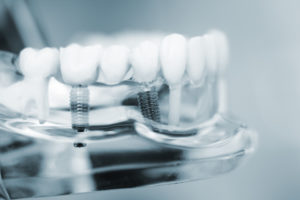
Few oral health issues are more concerning to patients than missing teeth. Fortunately your dentist in Sparks has many options that can help with this common problem. These include bridges, dentures and implants.
What is a Dental Bridge?
A dental bridge is an oral prosthetic that restores much of the functionality which is lost when a tooth is missing. The bridge is attached to healthy teeth on either side of the missing tooth and held in place with a special medical-grade adhesive. Bridges can last 10 years or longer with proper care.
Bridges do have their limitations. Foremost is the need for a healthy tooth on either side of the gap. Bridges may feel differently than natural teeth and require some getting used to. However, they are one way to correct the aesthetic and health issues associated with a missing tooth.
Types of Dentures
Dentures are an effective form of treatment for people who have lost some or all of their natural teeth. Modern dentures are comfortable, attractive and affordable. However they can sometimes cause changes in the patient’s facial structure due to bone loss. Traditional dentures can also make speaking and performing other daily tasks challenging. The patient must use adhesive to hold the appliance in place.
Implant-supported dentures can reduce the impact of these limitations. The dentist places a series of implants in the patient’s jaw, which in turn support a full or partial dental plate. The patient can still remove the restoration as needed for cleaning or other purposes. This option eliminates the need for adhesives and enables the patient to enjoy a fuller, more active life.
Dental Implants
An implant is a specially designed dental prosthetic that becomes part of the patient’s body through a normal process called osseointegration. The results are as close to a complete natural restoration as is possible with modern dental medicine. Implant procedures can take two forms:
- A tooth-by-tooth restoration. Because of cost and recovery time factors, this option is best reserved for patients who are only missing one or two teeth.
- A full plate restoration. With this option the dentist is able to restore all the teeth on the upper or lower jaw at the same time. The restoration is secured by 4 to 6 implants.
Most patients find that dental implants in Sparks are the best type of restoration currently available. Here’s why:
- Aesthetic benefits. The dentist can match the recipient’s contours and skin tones almost perfectly, making implants virtually indistinguishable from natural teeth.
- Lifestyle benefits. Because implants are so much like natural teeth there’s no reason to forgo the food you love, apply adhesives, or use special cleaning solutions.
- Orthopedic benefits. Implants stimulate the underlying bone, avoiding the jawline erosion problems that often occur with traditional dentures.
What about Crowns?
A crown is a type of restoration that sits atop a worn or damaged tooth. Crowns can restore lost functionality and resolve aesthetic issues. However, they require the tooth to have healthy roots and some degree of crown material remaining. You can get more information about this option from a dentist who provides one-visit crowns in Sparks.
In the end only a dentist can tell you which type of restoration is best in your case. Use the information in this post to discuss your options with him or her during your appointment. Whatever form of treatment you ultimately choose, we wish you and your loved ones lots of happy smiles for many years to come.
About the Author
Dr. Marc Thomas is an Army veteran, a skilled dentist and a member of the American Dental Association. He earned his DDS degree from University of the Pacific in 1993 and has been caring for patients ever since. You can reach his office online or by calling (775) 430-5355.
